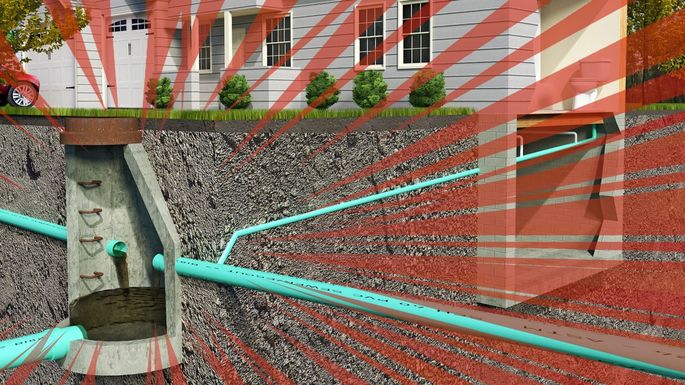Septic Tank Aerator Information for Atlanta, GA
There are two main reasons why people look into purchasing a septic tank aerator; when they’re installing a system and when a system has failed. At Atlanta Septic Tank Pros, our experienced partner technicians will be able to address these issues, and many more, but we’ve put together this quick guide to help you understand what aeration is, what it does, and what it can (and cannot) help with.
How Bacteria Affects Your System
All septic systems rely on bacteria to gobble up the solids and pathogens. It works an awful lot like your body’s digestive system. You have good bacteria and bad bacteria in your body. When the bad bacteria wins, whether it’s because your body is off balance or you’ve had to take antibiotics and the bad stuff regenerates first, you wind up with stomach pains and other issues. In your wastewater treatment system, there is also “bad” and “good” bacteria. The good stuff needs to be in the system to break down the waste and devour anything that’s dangerous, but it’s already there. It comes in with your waste and goes to town dining because you’re always adding “food” to your system for it.
Bacteria in the Reservoir
As you fill the reservoir with wastewater, it splits into three layers. The waste and dense materials sink and form a layer of sludge. The buoyant materials, like grease, form a layer that floats, called scum. The effluent, or liquid, sits in the middle.
The bacteria will reduce your sludge layer all by itself. It can convert as much as 50% of it into gas or liquid. The rest of the solids have to be pumped out on a regular basis. Once the center layer of effluent rises in a traditional system, it can move onto a second chamber, which works like the first, or it may move directly onto a leach field.
Bacteria in the Leach Field
When the tank is left alone and the solids either settle to the bottom or get eaten by bacteria, the effluent is largely free of debris, but it still has some of the bad bacteria and pathogens that we don’t want contaminating the water table. Thankfully, the soil has more of the good bacteria, that will take care of this if given the right environment and time. So, the effluent is channeled into a leach field, or a series of underground perforated pipes that evenly distribute it into the soil. The bacteria forms a layer call biomat, on both the soil and the inside of the lines. It holds the bad stuff there, giving it more time to be cleaned before it enters the soil. Once in the soil, the bacteria continues to clean the effluent, so it’s fairly pure before it reaches the water table.
What Does a Septic Tank Aerator Do?
Most systems run in an oxygen-deprived environment, but there are also alternative systems, including aerobic systems. These rely on the principle that the bacteria in an oxygen-rich environment will break down the solids in your reservoir faster, so aerobic systems are built with a special chamber or tank that adds air to the effluent. To be clear, aeration systems are built totally differently than standard reservoirs. A standard reservoir has one or two chambers for the material to settle in.
An aeration system usually has three to four distinct chambers or individual tanks. The first one is like a standard reservoir, where the solids get a chance to settle. The second one contains an aeration unit, hooked to an external air pump. You can liken this to the bubbler on a fish tank, but more powerful.

Once the effluent finishes in the aeration chamber, it moves to the next stage, which involves chlorination. Sometimes a whole reservoir is devoted to settling and chlorination, while other times the effluent simply passes through a chlorinator on the way to a settlement reservoir. In any case, it is always given a chance to settle again before it gets pumped out to the soil, and in most cases, aeration systems use sprinklers to disperse the effluent, not a leach field.
What Does an Aftermarket Septic Tank Aerator Do?
There are a lot of aftermarket septic tank aerator systems and they usually tell you that you won’t have to pump the sludge out again, or that your pumping needs will be less frequent if you install it. They even tell you that it can fix a system when the leach field has failed. They can’t and they don’t.
First off, the aeration system kicks up all that sludge from the bottom of the reservoir, but never gets a chance to “settle out.” You may notice that you have to pump less, and indeed, there may be more bacteria chowing away, but all that debris floating around winds up right in your leach field. It clogs it, grows the biomat excessively thick so it can’t drain, and it sends real actual solid waste out into your soil. Needless to say, this is quite unpleasant and unsanitary.
Call Atlanta Septic Tank Pros if You’re Considering a Septic Tank Aerator
If your system is failing, aeration can’t fix it. It may require pumping or repairs, but the underlying problem needs to be diagnosed and repaired by an experienced technician. Moreover, an aftermarket “fix” like this can do more harm than good. Always have an installation performed by a professional who understands how the system works and will make sure that it is done properly, so you aren’t damaging the system or cutting years off its life. To schedule an estimate, repairs, or an inspection with our partner, call (404) 998-8812 now.
